Key Takeaways
- Colors in Indian fashion are deeply rooted in cultural and religious symbolism
- Traditional Indian clothing features vibrant hues like saffron, indigo, and crimson
- Modern Indian fashion combines ancient color traditions with contemporary trends
- Specific colors hold sacred meanings in Hinduism, Buddhism, and other Indian faiths
- Regional variations influence color preferences in Indian clothing and textiles
- Natural dyes derived from plants, minerals, and insects create unique Indian colors
- Color blocking and intricate embroidery showcase India’s mastery of color combinations
- Indian designers blend western silhouettes with traditional Indian color palettes
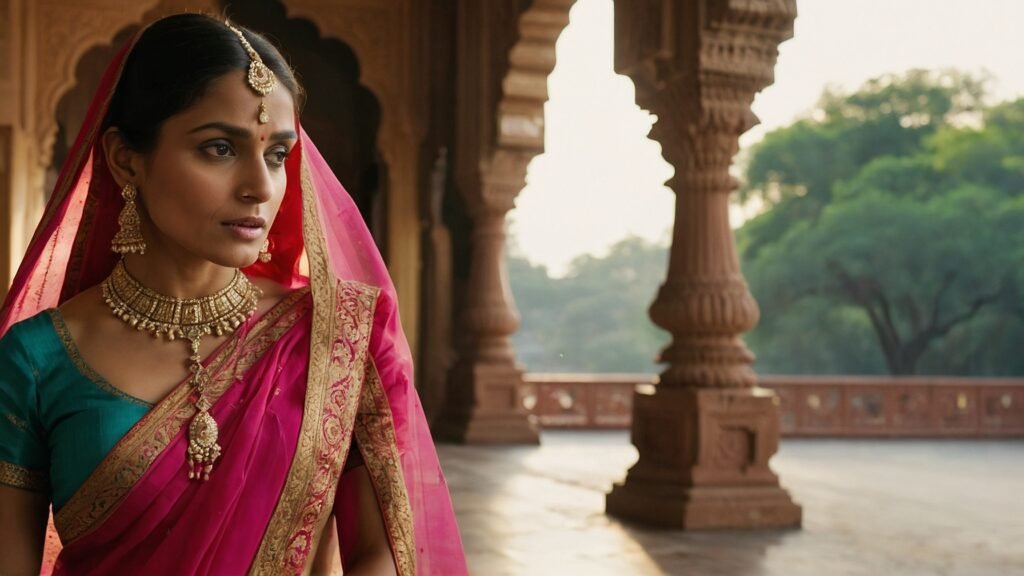
India is a kaleidoscope of colors and a vibrant tapestry shaped by ancient traditions, diverse cultures, and a deep-rooted love for vivid hues. From the saffron-tinted textiles of Rajasthan to the indigo-dyed fabrics of Tamil Nadu, the use of color in India’s rich heritage and cultural festivals is unmistakable.
Indian fashion are more than just aesthetic choices – they are imbued with profound symbolism, spirituality, and a celebration of life’s rich tapestry. This article delves into the captivating world of colors in Indian fashion, exploring the cultural significance, regional variations, and modern interpretations that make this fusion of hues a truly unique and enchanting experience.
The Roots of Color in Indian Fashion
The use of colors in Indian fashion is deeply intertwined with the country’s rich cultural heritage and religious beliefs. Each hue carries a symbolic meaning, with its roots tracing back to ancient texts, mythology, and sacred rituals. From the saffron robes of Hindu monks to the vermilion red adorning the foreheads of married women, colors have played a pivotal role in representing various aspects of Indian society, spirituality, and traditions.
Sacred Symbolism
In Hinduism, colors hold profound significance, with each hue representing a specific deity, chakra, or cosmic element. Saffron, for instance, symbolizes purity, asceticism, and the pursuit of spiritual enlightenment, while crimson red is associated with fertility, prosperity, and the divine feminine energy. Indigo, on the other hand, is revered for its connection to the infinite expanse of the universe and the pursuit of inner wisdom.
Similarly, in Buddhism and Jainism, colors play a crucial role in representing the virtues and teachings of these ancient philosophies. The saffron robes of Buddhist monks signify detachment from worldly possessions, while the white garments of Jain ascetics symbolize non-violence, purity, and the path to spiritual liberation.
Regional Variations
India’s diverse geography and cultural landscape have given rise to regional variations in color preferences and traditions. In the arid deserts of Rajasthan, earthy tones like ochre, rust, and terracotta are prominently featured in traditional attire, reflecting the vibrant hues of the desert landscape. In contrast, the lush greenery and tropical climate of Kerala have influenced the use of cool, soothing shades like turquoise, emerald, and jade in local textiles and clothing.
India’s diverse climate and rich natural resources have significantly influenced the color palette of traditional Indian fashion. For example, regions abundant in indigo-producing plants saw the extensive use of vibrant blue hues in traditional Indian textiles. Meanwhile, the presence of turmeric and other natural dye sources in different areas contributed to the warm, earthy colors commonly seen in regional Indian clothing styles. These environmental factors have shaped the distinctive and colorful nature of Indian fashion throughout history.
Natural Dyes and Textiles
One of the most captivating aspects of traditional Indian fashion is the use of natural dyes sourced from plants, minerals, and even insects. These ancient dyeing techniques have been handed down through generations, creating a vibrant palette of colors that define Indian textiles. The result is not only visually stunning garments but also eco-friendly and sustainable fashion that honors India’s rich heritage.
The iconic indigo dye, obtained from the Indigofera tinctoria plant, has been a staple in Indian textile production for centuries, producing a range of mesmerizing blues that have become synonymous with Indian fashion. Similarly, the vibrant reds and oranges found in many traditional garments are derived from natural sources like madder root, pomegranate rind, and the crimson hues extracted from the lac insect.

The Significance of Color in Traditional Indian Attire
Traditional Indian clothing is a living canvas that showcases the country’s mastery of color combinations, intricate embroidery, and unique textile techniques. From the resplendent saris adorned with delicate zari work to the vibrant lehengas adorned with intricate gota embroidery, each garment tells a story through its carefully curated color palette and design elements.
Saris and Regional Drapes
The sari, a quintessential Indian garment, is a testament to the country’s rich heritage and love for colors. Each region has its own distinct sari-draping style and preferred color combinations. The Banarasi saris from Varanasi, for instance, are renowned for their intricate brocade patterns woven in golden threads against rich backgrounds of crimson, emerald, and indigo.
In the southern states of India, the Kanjivaram and Pattu saris from Tamil Nadu feature vibrant hues like deep reds, greens, and blues, often accentuated with intricate zari work and temple borders. These saris not only showcase the region’s textile prowess but also reflect the vibrant colors found in the local flora and fauna.
Lehengas and Sherwani
The lehenga, a traditional Indian ensemble consisting of a long, flared skirt and a fitted choli (blouse), is another canvas for color experimentation. From the vibrant pinks and oranges favored in Rajasthani lehengas to the intricate embroidery and mirror work adorning Punjabi lehengas, each region has its own unique take on color combinations and design elements.
For men, the sherwani, a long coat-like garment, is a celebration of regal colors and intricate embroidery. Traditionally crafted in rich hues like maroon, navy, and emerald green, the sherwani is often adorned with delicate zardozi work and paired with a complementary churidar or pajama, creating a harmonious interplay of colors and patterns.
Color Blocking and Pattern Mixing
- Bold color blocking in saris, lehengas, and kurtas
- Mixing vibrant prints with solid hues
- Combining contrasting colors like pink and orange
- Layering different textiles with complementary colors
- Incorporating embroidery and mirror work in clashing color combinations
- Pairing bright hues with metallic accents like gold and silver
- Combining traditional Indian colors with contemporary western shades
- Creating ombre effects with gradients of the same hue
- Mixing geometric patterns with floral motifs in contrasting colors
- Experimenting with monochromatic color schemes with varying textures
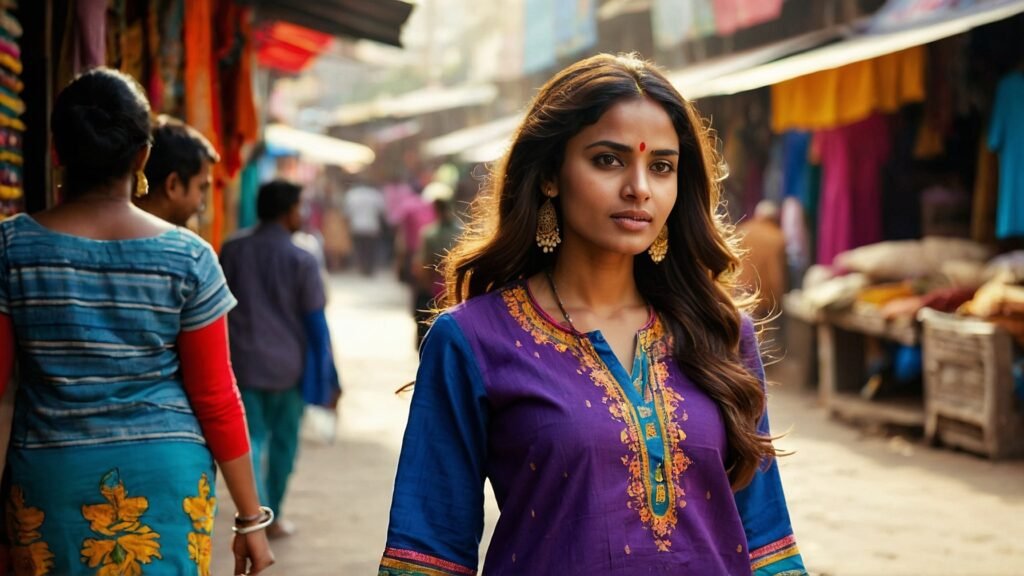
The Modern Fusion of Colors in Indian Fashion
As India embraces globalization and contemporary trends, the country’s fashion landscape has witnessed a seamless fusion of traditional color sensibilities with modern aesthetics. Indian designers and fashion enthusiasts have skillfully blended ancient color traditions with contemporary silhouettes, creating a unique and captivating synthesis that celebrates the best of both worlds.
One of the most prominent trends in modern Indian fashion is the reinterpretation of traditional garments through a contemporary lens. Designers are reimagining classic saris, lehengas, and kurtas with bold color combinations, incorporating western cuts and silhouettes while retaining the essence of Indian heritage. This fusion has given rise to a new generation of fashion-forward individuals who embrace their cultural roots while embracing global fashion trends.
Another notable evolution in Indian fashion is the incorporation of sustainable and eco-friendly practices, which has influenced the use of colors and dyeing techniques. Many designers and artisans are reviving ancient methods of natural dyeing, utilizing plant-based dyes and mineral pigments to create garments that are not only visually stunning but also environmentally conscious. This approach has resulted in a renewed appreciation for earthy tones, muted hues, and the unique variations that come with natural dyes.
Alongside these developments, urban Indian fashion has embraced a bold and unapologetic use of color. Striking hues like fuchsia, cobalt blue, and neon greens have found their way into contemporary Indian streetwear, with designers and fashion enthusiasts alike experimenting with daring color combinations and unexpected pairings. This fearless approach to color has given rise to a new generation of trendsetters who celebrate self-expression and individuality through their fashion choices.
Moreover, Indian fashion has transcended borders, with global fashion houses and international designers drawing inspiration from the rich color heritage of the subcontinent. From the vibrant hues of Indian spices to the intricate patterns of traditional textiles, Indian colors have found their way onto the runways of fashion capitals around the world, captivating audiences with their beauty and cultural significance.
The Art of Color Combinations
One of the hallmarks of Indian fashion is the intricate art of combining colors in a harmonious and visually striking manner. From the delicate pastel hues of Lucknowi chikankari embroidery to the bold contrasts of Gujarati mirror work, Indian designers and artisans have mastered the skill of creating captivating color combinations that showcase the country’s rich cultural heritage.
Traditional Color Palettes
Traditional Indian color palettes are often inspired by the vibrant hues found in nature, such as the deep reds and oranges of spices, the rich blues and greens of precious stones, and the earthy tones of the diverse landscapes. These color combinations have been passed down through generations, with each region developing its own unique aesthetic.
In Rajasthan, the color palette is heavily influenced by the desert landscape, featuring warm shades of saffron, ochre, and rust, often paired with vibrant pinks, blues, and greens. In contrast, the textiles of Gujarat are renowned for their bold clashes of red, yellow, and indigo, creating striking patterns and motifs that reflect the region’s vibrant culture.
Contemporary Interpretations
While traditional color combinations remain a source of inspiration, modern Indian designers have also embraced contemporary interpretations of color palettes. Many have incorporated global trends and western influences into their designs, creating a unique fusion of East and West.
One notable trend is the use of monochromatic color schemes, where designers explore various shades and tones of a single hue, creating depth and texture through the layering of fabrics and embellishments. This minimalist approach allows the intricate details and craftsmanship of Indian textiles to take center stage.
Another contemporary interpretation is the incorporation of unexpected color combinations, such as pairing muted pastels with bold jewel tones or combining earthy neutrals with vibrant neons. This daring approach to color has challenged traditional norms and showcased the versatility of Indian fashion in adapting to global aesthetics.
Embroidery and Surface Embellishments
No discussion of color in Indian fashion would be complete without acknowledging the intricate art of embroidery and surface embellishments. These decorative techniques not only add visual interest and texture to garments but also create a stunning interplay of colors and patterns.
From the delicate zari embroidery of Banaras to the intricate mirror work of Kutch, each region in India boasts its own unique embroidery traditions, often featuring distinct color combinations and motifs. The skilled hands of artisans meticulously apply threads, beads, and sequins to create captivating designs that celebrate the country’s rich cultural heritage.
One of the most mesmerizing examples of surface embellishment is the gota patti work, which originated in Rajasthan. This technique involves applying intricate patterns of golden or silver kinari (ribbons) onto fabrics, creating a shimmering effect that complements the vibrant colors of the garments.
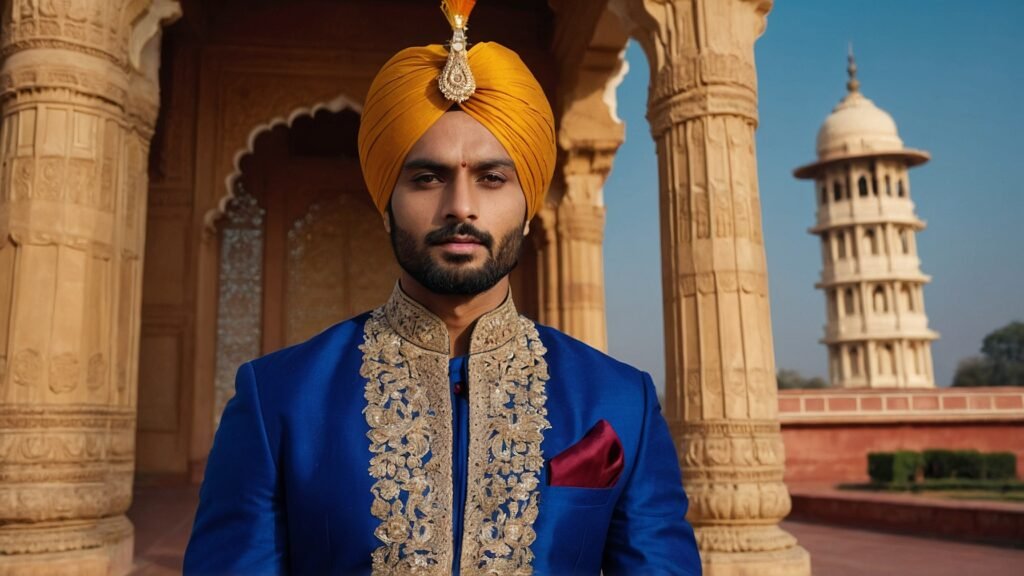
The Psychology of Color in Indian Fashion
- Red symbolizing passion, fertility, and auspiciousness
- Orange representing warmth, spiritual awareness, and creativity
- Yellow associated with knowledge, happiness, and enlightenment
- Green signifying nature, growth, and new beginnings
- Blue representing calmness, intelligence, and stability
- Purple linked to royalty, luxury, and spirituality
- White symbolizing purity, peace, and simplicity
- Black representing power, mystery, and elegance
- Pink denoting love, femininity, and playfulness
- Saffron representing sacrifice, renunciation, and wisdom
- Indigo connected to meditation, intuition, and depth
- Vermilion red symbolizing marital status and prosperity
- Earthy tones reflecting the natural environment and grounding
- Metallic hues like gold and silver signifying opulence and grandeur
The Symbolism of Colors in Indian Weddings
In Indian culture, weddings are not merely celebrations of love but also grand events steeped in tradition, symbolism, and vibrant colors. Each hue adorning the bridal attire, decor, and rituals carries deep significance, representing the hopes, dreams, and blessings of the newlyweds as they embark on their journey together.
The Bridal Color Palette
At the heart of every Indian wedding lies the bridal ensemble, which is a breathtaking display of colors, intricate embroidery, and exquisite craftsmanship. The traditional colors for bridal wear vary across regions and communities, but certain hues hold universal significance.
Red, in all its fiery shades, is perhaps the most iconic color associated with Indian bridal wear. It symbolizes love, fertility, and prosperity, making it a popular choice for the bridal lehenga or sari. Other vibrant hues like pink, orange, and yellow are also favored, representing joy, warmth, and happiness.
Ceremonial Colors and Rituals
Beyond the bridal attire, colors play a crucial role in various wedding ceremonies and rituals. In Hindu weddings, for instance, the haldi (turmeric) ceremony involves applying a paste made from turmeric, sandalwood, and other natural ingredients to the bride and groom. The bright yellow hue of turmeric is believed to bestow blessings, purification, and protection upon the couple.
During the Sindoor Daan ceremony, vermilion red powder is applied to the bride’s hairline by the groom, symbolizing her new status as a married woman and signifying love, commitment, and prosperity. Similarly, the use of marigold flowers in wedding decor and garlands symbolizes the sun, life, and new beginnings, adding vibrant pops of orange and yellow to the festivities.
Regional and Cultural Variations
While certain colors and their symbolism are universal across Indian weddings, regional and cultural variations also influence the color choices and traditions. In the southern states of India, where the Dravidian culture holds sway, bridal wear often features rich shades of green, purple, and mustard yellow, complemented by intricate zari work and temple borders.
In the northern regions, such as Punjab and Rajasthan, the color palette for weddings is heavily influenced by the vibrant hues of the desert landscapes, with shades of red, orange, and pink taking center stage. Phulkari embroidery, a traditional craft from Punjab, adds a kaleidoscope of colors to bridal ensembles, incorporating intricate floral patterns and geometric motifs.
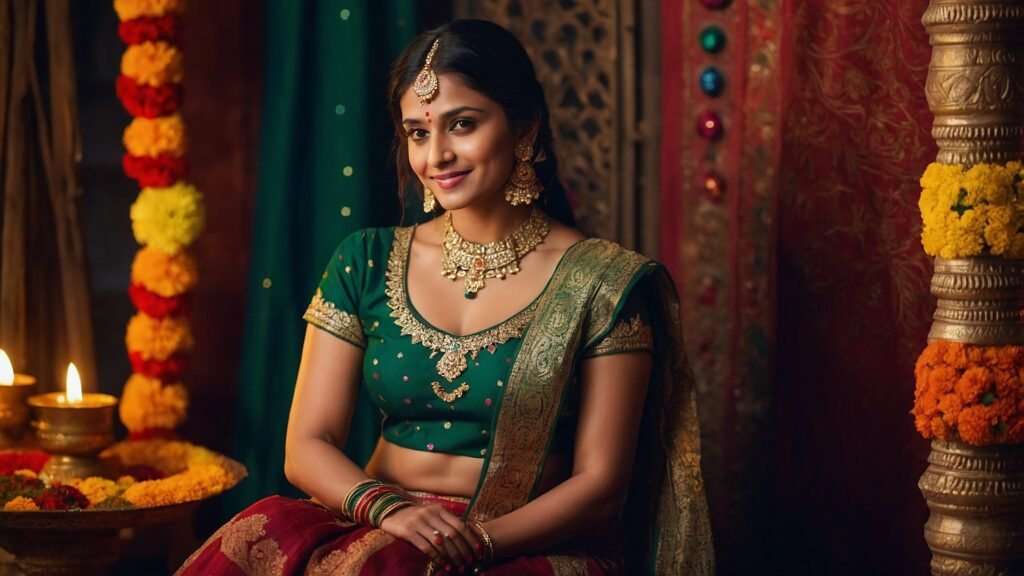
Color Therapy and Healing in Indian Traditions
- Use of colored gemstones and crystals for balancing chakras
- Chromotherapy (color therapy) in Ayurvedic practices
- Wearing specific colors to promote physical and emotional well-being
- Color meditation for enhancing mental clarity and focus
- Incorporating colored lights and candles in healing rituals
- Utilizing colored fabrics and textiles for energy healing
- Applying colored powders (like haldi) for purification and protection
- Wearing colored threads or strings for warding off negative energies
- Using colored oils and essences in aromatherapy and massage
- Decorating homes and workspaces with colors that promote harmony
- Incorporating colored foods and spices for their therapeutic properties
- Practicing color breathing exercises for stress relief and relaxation
- Creating color mandalas for meditation and self-expression
- Utilizing color visualization techniques for manifestation and healing
The Influence of Colors in Indian Festivals and Celebrations
India is a land of vibrant festivals, each one a kaleidoscope of colors, traditions, and joyous celebrations. From the colorful powder play of Holi to the dazzling fireworks of Diwali, colors hold a special significance in these festivities, reflecting the country’s diverse cultural tapestry and the deep-rooted symbolism associated with each hue.
Holi: The Festival of Colors
Holi, the ancient Hindu festival of colors, is a celebration of love, unity, and the arrival of spring. On this vibrant occasion, people from all walks of life take to the streets, playfully smearing each other with gulal (colored powder) and exchanging wishes of happiness and prosperity.
Diwali: The Festival of Lights
Diwali, the festival of lights, is a magnificent celebration that illuminates the streets and homes of India with thousands of twinkling diyas (oil lamps) and colorful rangoli patterns. While the primary colors associated with Diwali are the warm hues of orange and yellow, symbolizing knowledge and prosperity, the festival also incorporates a myriad of other vibrant shades.
Dazzling fireworks in shades of red, green, and blue light up the night sky, creating a mesmerizing display of colors that represent the triumph of light over darkness, good over evil. Traditional Indian attire during Diwali often features rich, jewel-toned hues like ruby red, emerald green, and sapphire blue, reflecting the opulence and joy of the occasion.
Regional Festivals and Celebrations
Beyond the major festivals celebrated nationwide, each region in India has its own unique celebrations that are deeply intertwined with local traditions and colors. In the southern state of Tamil Nadu, the vibrant Pongal festival marks the beginning of the harvest season, with colorful kolams (rangoli patterns) adorning the entrances of homes and the streets filled with the hues of fresh produce.
In the western state of Gujarat, the Navratri festival is a nine-day celebration of the divine feminine energy, where women and men alike dress in vibrant hues of red, green, and yellow, performing traditional dances and adorning their hands with intricate henna designs.
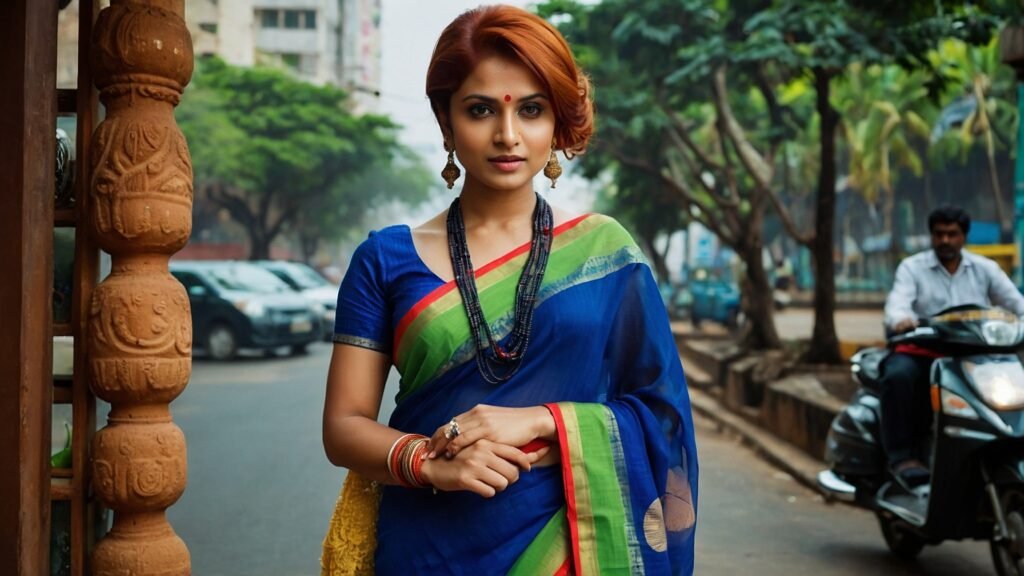
The Cultural Significance of Colors in Indian Art and Architecture
India’s rich cultural heritage is not only reflected in its fashion and festivals but also in its awe-inspiring art and architecture. From the intricately painted frescoes of ancient temples to the vibrant hues adorning the magnificent Mughal monuments, colors have played a pivotal role in conveying symbolic meanings, religious beliefs, and artistic expressions.
The ancient art of fresco painting, prevalent in the temples and palaces of India, showcased a masterful use of colors derived from natural pigments. The vivid reds, blues, and yellows portrayed in these frescoes depicted scenes from Hindu mythology, imbuing the walls with a sense of divine energy and spiritual significance.
Architecture and Monuments
Indian architecture is a canvas of colors, where each hue holds a deeper meaning and contributes to the overall grandeur and symbolism of the structures. The iconic Taj Mahal, a testament to the Mughal era’s architectural brilliance, features intricate inlay work of precious and semi-precious stones, creating a mesmerizing interplay of colors against the pristine white marble.
The majestic forts and palaces of Rajasthan are adorned with vibrant frescos, intricate carvings, and colorful tile work, reflecting the region’s love for bold hues and intricate patterns. The City Palace in Jaipur, famously known as the “Pink City,” is a stunning example of how color can define the character and identity of a place, with its distinctive pink hue representing warmth and hospitality.
Contemporary Art and Design
In the realm of contemporary Indian art and design, colors continue to play a pivotal role, with artists and designers drawing inspiration from the country’s rich cultural heritage while incorporating modern sensibilities and global influences.
Indian contemporary artists have gained international recognition for their bold use of colors and their ability to convey complex narratives and emotions through their vibrant canvases. From the abstract expressionism of Sayed Haider Raza to the pop art style of Anju Dodiya, Indian artists have pushed the boundaries of color exploration, creating works that celebrate the country’s diversity and evoke a sense of wonder and contemplation.
In the field of design, Indian aesthetics have influenced global trends, with the use of intricate patterns, vibrant hues, and traditional motifs becoming increasingly popular in interior design, fashion, and product design. Indian designers have seamlessly fused traditional craftsmanship with modern sensibilities, creating pieces that are not only visually stunning but also deeply rooted in cultural significance.
Summary Table
| Color | Symbolism | Cultural Significance |
|---|---|---|
| Red | Love, fertility, prosperity | Bridal wear, weddings, festivals |
| Saffron | Purity, renunciation, wisdom | Hindu monasticism, spiritual pursuits |
| Indigo | Infinity, depth, intuition | Traditional textiles, meditation |
| Green | Nature, growth, new beginnings | Renewal, fertility, prosperity |
| Blue | Calmness, intelligence, stability | Tranquility, spirituality, loyalty |
| Yellow | Knowledge, happiness, enlightenment | Purification, auspiciousness, wisdom |
| Orange | Warmth, creativity, spiritual awareness | Joy, energy, celebration |
| Purple | Royalty, luxury, spirituality | Opulence, divinity, mysticism |
Conclusion
The vibrant tapestry of colors in Indian fashion is a testament to the country’s rich cultural heritage, profound spirituality, and innate appreciation for beauty and symbolism. From the saffron robes of Hindu monks to the intricate zari embroidery on bridal lehengas, each hue holds a deeper meaning, reflecting the diverse traditions, beliefs, and regional influences that shape the Indian subcontinent.
As India continues to embrace modernity while honoring its ancient roots, the colors in its fashion continue to evolve, seamlessly blending traditional sensibilities with contemporary aesthetics. Whether it’s the bold color-blocking of urban streetwear or the sustainable practices of natural dyeing, Indian fashion remains a captivating canvas that celebrates the vibrant hues of life, love, and cultural identity.
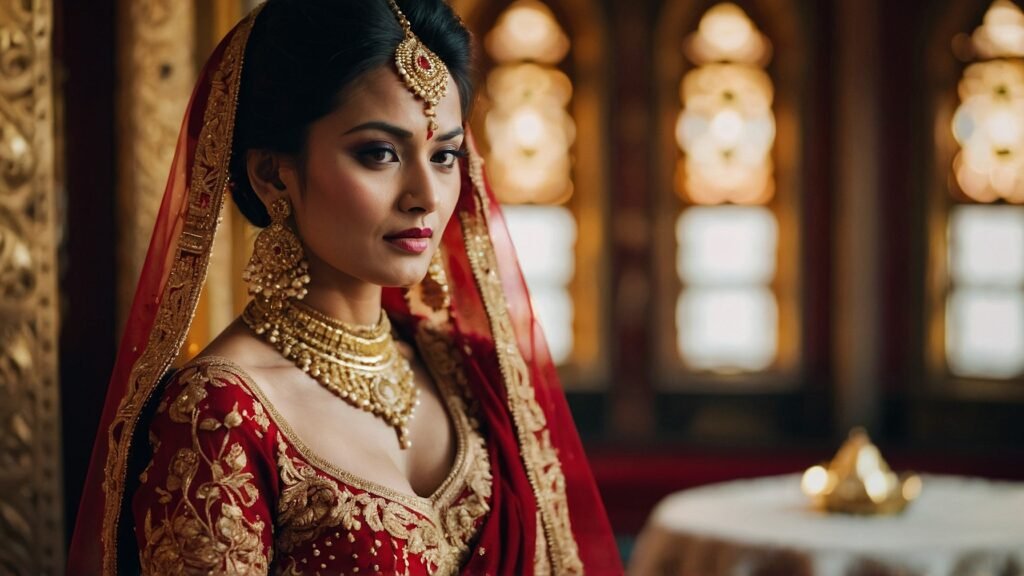
Frequently Asked Questions
What is the significance of the color red in Indian culture?
The color red holds immense significance in Indian culture and is associated with various aspects of life. It symbolizes love, fertility, prosperity, and auspiciousness. In Hindu weddings, the bridal attire, predominantly red, represents the bride’s new married status and the blessings of fertility and abundance. Red is also a prominent color during festivals like Holi and Lohri, celebrating the arrival of spring and the harvesting season. Additionally, the red vermilion powder (sindoor) is applied on the hairline of married women, signifying their marital status and commitment.
Why is saffron an important color in Indian traditions?
Saffron, or the deep orange-yellow hue, is a revered color in Indian traditions, particularly in Hinduism and Buddhism. In Hinduism, saffron represents purity, asceticism, and the pursuit of spiritual enlightenment. It is the color of the robes worn by Hindu monks and ascetics, symbolizing their renunciation of material possessions and worldly attachments. In Buddhism, saffron is associated with the Buddha’s teachings and the path towards inner peace and enlightenment. The saffron robes worn by Buddhist monks symbolize their detachment from worldly desires and their commitment to spiritual growth.
What is the significance of indigo in Indian textiles?
Indigo, a deep and rich blue hue, holds a special place in Indian textile traditions. It is derived from the Indigofera tinctoria plant, and the art of indigo dyeing has been practiced in India for centuries. Indigo-dyed fabrics, such as the iconic Indian denim and the vibrant textiles from regions like Rajasthan and Gujarat, are renowned worldwide for their beauty and cultural significance.
In Indian culture, indigo is often associated with the infinite expanse of the universe, depth, and intuition. It is believed to have a calming and meditative effect, promoting inner peace and spiritual growth. The use of indigo in textiles not only showcases India’s mastery of natural dyes but also represents the country’s deep connection with nature and traditions.
How are colors used in Indian weddings?
Colors play a crucial role in Indian weddings, carrying deep symbolic meanings and representing various cultural traditions. The bridal attire, such as the lehenga or sari, is often adorned in vibrant hues like red, pink, and orange, symbolizing love, fertility, and prosperity. During the ceremonies, colors like turmeric yellow (for the haldi ceremony), vermilion red (for the sindoor daan ritual), and marigold orange (for floral decorations) hold significant cultural and spiritual meanings.
Regional variations also influence the color choices in Indian weddings. For example, in the southern states, bridal wear often features rich shades of green, purple, and mustard yellow, while in the northern regions, shades of red, orange, and pink are more prevalent. Overall, colors in Indian weddings create a visually stunning and culturally rich tapestry, reflecting the diverse traditions and beliefs of different communities.
What is the role of colors in Indian festivals?
Colors play a vital role in Indian festivals, adding vibrancy, symbolism, and cultural richness to the celebrations. During Holi, the festival of colors, people joyously smear each other with vibrant gulal (colored powder) in shades of red, pink, blue, and green, symbolizing the arrival of spring and the triumph of good over evil.
In Diwali, the festival of lights, homes are adorned with colorful rangoli patterns, and the night sky is illuminated by dazzling fireworks in hues of red, green, and blue. Regional festivals like Pongal in Tamil Nadu and Navratri in Gujarat also incorporate vivid colors in their celebrations, reflecting local traditions and beliefs.
Overall, colors in Indian festivals represent joy, unity, blessings, and the diverse cultural tapestry of the country, making them an integral part of these joyous occasions.
How are colors used in Indian art and architecture?
Colors hold immense significance in Indian art and architecture, serving as a medium to convey symbolic meanings, religious beliefs, and artistic expressions. Ancient fresco paintings in temples and palaces showcased vivid reds, blues, and yellows derived from natural pigments, depicting scenes from Hindu mythology and imbuing the spaces with divine energy.
In architecture, colors played a crucial role in defining the grandeur and symbolism of monuments. The iconic Taj Mahal features intricate inlay work of precious stones, creating a mesmerizing interplay of colors against the pristine white marble. The majestic forts and palaces of Rajasthan are adorned with vibrant frescos, intricate carvings, and colorful tile work, reflecting the region’s love for bold hues and intricate patterns.
Contemporary Indian art and design continue to draw inspiration from the country’s rich cultural heritage, with artists and designers using colors to convey complex narratives, emotions, and global influences.
What is the significance of natural dyes in Indian textiles?
Natural dyes hold a significant place in Indian textile traditions, reflecting the country’s deep connection with nature and sustainable practices. For centuries, Indian artisans have skillfully extracted vibrant hues from plants, minerals, and even insects, creating a wide range of rich and unique colors for dyeing fabrics.
Indigo, obtained from the Indigofera tinctoria plant, is one of the most iconic natural dyes used in Indian textiles, producing mesmerizing shades of blue. Other natural dyes include madder root for reds, pomegranate rind for oranges, and the crimson hues extracted from the lac insect.
The use of natural dyes not only showcases India’s mastery of traditional dyeing techniques but also aligns with the growing emphasis on eco-friendly and sustainable practices in the textile industry. These age-old methods have been passed down through generations, preserving the cultural heritage and promoting environmental consciousness.
How are colors used in Indian traditional attire?
Colors play a vital role in traditional Indian attire, reflecting the country’s diverse cultural heritage and regional variations. The sari, a quintessential Indian garment, is a canvas for vibrant hues and intricate embroidery, with each region having its distinct color preferences and styling traditions.
In the north, Banarasi saris feature rich backgrounds of crimson, emerald, and indigo, adorned with golden brocade patterns. In the south, Kanjivaram and Pattu saris often showcase deep reds, greens, and blues, complemented by zari work and temple borders.
Lehengas, another popular traditional ensemble, also incorporate bold color combinations and intricate embroidery. Rajasthani lehengas feature vibrant pinks and oranges, while Punjabi lehengas showcase mirror work and embroidery in contrasting hues.
Overall, the use of colors in traditional Indian attire celebrates the country’s rich cultural tapestry, regional diversity, and the artistry of skilled craftspeople.

Matthew Mansour, known in the fashion world as a storytelling virtuoso, weaves captivating tales centered around the mesmerizing universe of fashion hues. Possessing a sharp eye for detail, Matthew explores the profound layers of color combinations, turning the simple act of choosing an outfit into a lively adventure. His unique ability to blend emotion and innovation into his writings sets him apart in the sartorial sphere. Each article penned by him carries a touch of magic, inspiring readers to embark on a colorful odyssey through the diverse landscape of apparel shades.
Reviewed By: Joanna Perez and Anna West
Edited By: Lenny Terra
Fact Checked By: Marcella Raskin
Photos Taken or Curated By: Matthew Mansour
